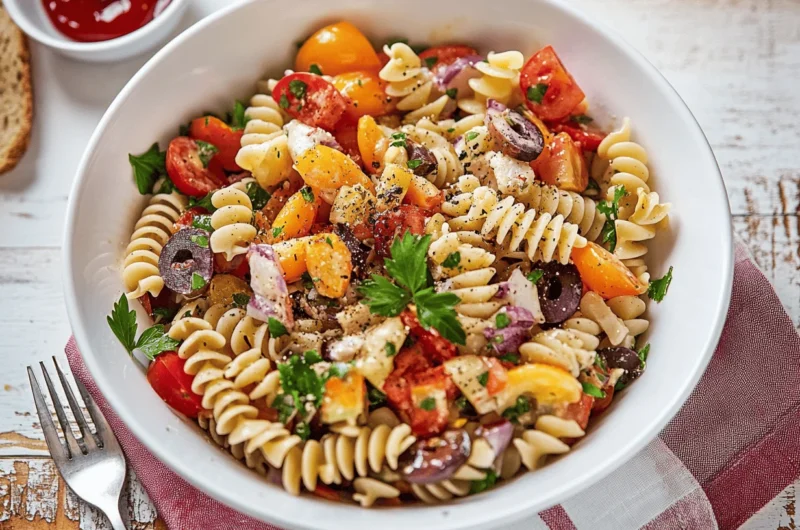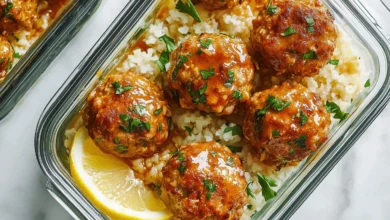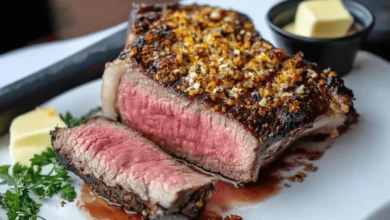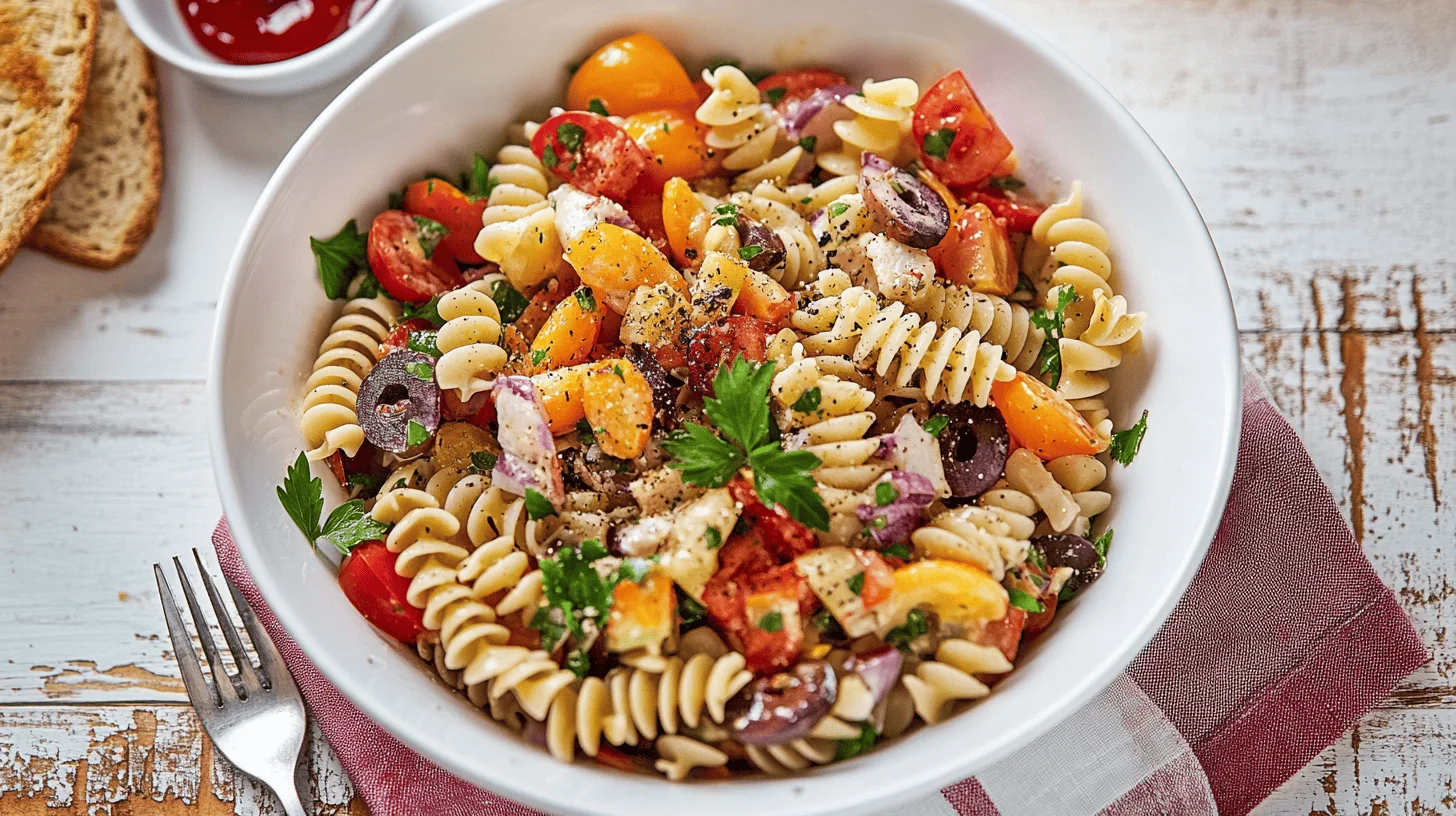
Italian Pasta Salad
Table of Contents
There are certain dishes that transcend mere nutrition to become culinary celebrations of flavor, texture, and visual delight. The Italian Pasta Salad stands as perhaps the most perfect embodiment of this transformation. This isn’t just a side dish; it’s a symphony of Mediterranean ingredients that dance together in vibrant harmony.
From the moment you first encounter this pasta salad, your senses are engaged in a delightful conversation. The al dente rotini spirals create the perfect architecture to capture the tangy dressing, while colorful vegetables provide both visual appeal and textural contrast. The marinated artichokes and kalamata olives introduce sophisticated brine notes, while the cured salami adds savory depth that elevates this beyond typical pasta salads. Fresh mozzarella contributes its milky tenderness, melting slightly into the warm pasta before cooling to create pockets of creamy indulgence throughout the dish.
What makes this particular pasta salad exceptional is its perfect balance between simplicity and complexity. The ingredients are straightforward and accessible, yet together they create a flavor profile that feels both familiar and intriguing. The preparation requires minimal cooking prowess, yet the results suggest culinary expertise.
While my Garlic Parmesan Chicken Pasta represents comfort food at its finest, this pasta salad offers a refreshing counterpoint perfect for warm weather gatherings, meal prep convenience, or simply elevating an ordinary weekday lunch into something extraordinary.
I invite you to bring this colorful creation to your next gathering, prepare it for a week of delicious lunches, or serve it alongside grilled proteins for a complete meal. One taste, and you’ll understand why this pasta salad has earned its place as a perennial favorite on tables across America.
What is Italian Pasta Salad?
Have you ever wondered why something as simple as pasta tossed with vegetables and dressing inspires such devotion? Italian Pasta Salad represents that rare culinary achievement: a dish that simultaneously satisfies the cook (through its forgiving preparation and make-ahead convenience) and delights the eater (through its vibrant flavors and textures).
The name itself reveals its cross-cultural heritage. While pasta’s Italian origins are undisputed, the concept of serving it cold, dressed with vinaigrette rather than hot sauce, represents an American adaptation of Mediterranean ingredients. Some food historians suggest this hybrid creation emerged in the mid-20th century as Italian-American communities adapted traditional recipes to suit casual entertaining and potluck gatherings. They say the way to a friend’s heart is through a memorable potluck contribution, and few dishes have won more affection than this colorful pasta medley!
What distinguishes “Italian” pasta salad from other varieties is its specific flavor profile: the tangy red wine vinaigrette, the inclusion of Italian-inspired ingredients like salami, mozzarella, and herbs, and the perfect balance of savory, briny, fresh, and acidic elements. Whether this authentically represents Italian cuisine is beside the point; this beloved creation has earned its place in the American culinary landscape through sheer deliciousness alone.
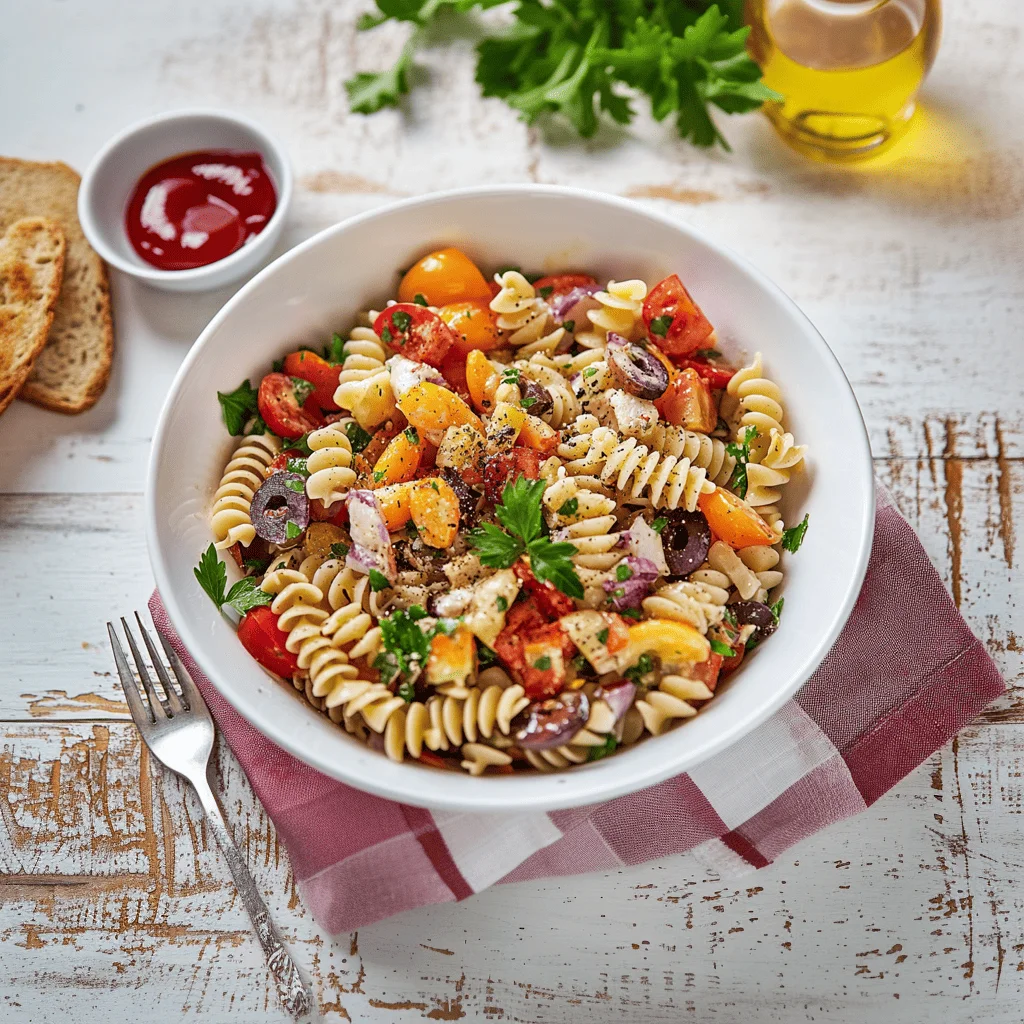
Why You’ll Love This Italian Pasta Salad:
A Spectacular Symphony of Flavors and Textures
What elevates this Italian Pasta Salad beyond ordinary pasta dishes is its remarkable interplay of distinct yet complementary elements. Each forkful delivers a different experience as you encounter pockets of tanginess from the vinaigrette-soaked pasta, brightness from fresh tomatoes, richness from the salami, brininess from olives and capers, and creamy indulgence from fresh mozzarella. The spiral shape of rotini pasta performs the essential function of capturing dressing in its crevices, ensuring flavor distribution throughout the dish. The combination of soft (mozzarella, artichokes) and firm (pasta, bell peppers) textures creates a satisfying mouthfeel that keeps each bite interesting. This careful orchestration of ingredients stimulates multiple taste receptors simultaneously, creating that elusive quality that makes certain dishes impossible to stop eating.
Impressive Economy for Entertaining Excellence
Beyond its gustatory appeal, this pasta salad represents remarkable financial efficiency, particularly when entertaining. While prepared deli pasta salads typically command $8-12 per pound, this homemade version costs approximately $2.50-3.00 per serving, representing a 60-70% cost reduction. For a gathering of 8-10 people, this translates to approximately $35-50 in savings compared to store-bought alternatives of similar quality. The recipe’s inherent flexibility also allows for strategic ingredient substitutions based on seasonal availability and sales, further enhancing its economic advantage. Perhaps most valuable is the temporal economy it provides; the make-ahead nature of this dish (it actually improves after refrigeration) allows hosts to prepare it entirely before guests arrive, freeing valuable time during the event itself for socializing rather than cooking.
Versatility That Adapts to Your Needs
The adaptable nature of this Italian Pasta Salad extends beyond mere ingredient flexibility to encompass multiple serving scenarios and dietary accommodations. As a standalone lunch, it provides complete nutrition through its balance of carbohydrates, proteins, and vegetables. As a side dish, it complements virtually any grilled protein, from chicken to seafood. For vegetarian guests, simply omit the salami and increase the mozzarella for a satisfying meatless option. The salad performs equally well in formal settings (served in a decorative bowl at a dinner party) and casual contexts (packed in containers for a picnic). It maintains its quality for 3-4 days refrigerated, making it ideal for meal preparation scenarios where cook-once-eat-multiple-times efficiency is desired. Perhaps most impressively, it can be adapted seasonally, incorporating spring asparagus, summer corn, or fall roasted squash depending on availability.
When compared to my Peanut Butter Pie Recipes, which provide dessert decadence, this pasta salad delivers similar satisfaction in savory form, making it the perfect counterpart in a complete meal plan. I encourage you to experience this culinary chameleon for yourself, adapting it to your specific preferences and needs while maintaining the essential balance that makes it so irresistible.
How to Make Italian Pasta Salad:
Quick Overview
This Italian Pasta Salad transforms simple ingredients into a cohesive dish greater than the sum of its parts. The genius lies in its construction methodology: marinating onions in dressing, then adding hot pasta to this mixture allows the starch to absorb flavors at the molecular level rather than merely coating the exterior. The strategic addition of ingredients in stages ensures proper integration without compromising the integrity of delicate components. The inclusion of both dried and fresh herbs creates flavor depth impossible to achieve through either alone. This 25-minute preparation yields a dish that serves equally well as a substantial side or light main course, with the remarkable quality of improving over 24 hours as flavors meld and develop in refrigeration.
Each component serves a specific purpose in the overall composition: the spiral pasta provides structural integrity and dressing capture capacity; the vegetables contribute freshness and textural contrast; the cured meats and cheeses add protein and savory depth; the brined elements (olives, capers, artichokes) provide concentrated flavor bursts; and the herbs weave aromatic complexity throughout the dish.
What to Serve Italian Pasta Salad With:
The versatility of Italian Pasta Salad extends to its exceptional pairing potential across multiple culinary contexts. Consider these thoughtfully curated companions that create balanced and satisfying meal experiences:
From the Grill:
- Lemon-Herb Grilled Chicken: The bright citrus notes and herbaceous character complement the salad’s Mediterranean profile while adding lean protein. This pairing works beautifully with my Crispy Fried Chicken Drumsticks preparation technique.
- Grilled Skirt Steak: The rich, caramelized exterior of properly grilled skirt steak, especially when prepared with my Best Skirt Steak Marinade, creates a satisfying contrast to the tangy pasta salad.
- Mediterranean Shrimp Skewers: Garlicky, herb-infused shrimp provide light protein that echoes the salad’s flavor profile while introducing a different textural element.
For Vegetarian Contexts:
- Grilled Halloumi: This non-melting cheese develops a remarkable crust when grilled while remaining soft inside, offering a protein option that harmonizes with the Mediterranean theme.
- Marinated White Bean Salad: A simple side of white beans dressed with lemon, herbs, and olive oil extends the Mediterranean theme while adding fiber and plant protein.
- Roasted Vegetable Platter: Seasonal vegetables like zucchini, eggplant, and bell peppers, roasted until caramelized, create a satisfying vegetable-forward meal alongside the pasta salad.
Bread Companions:
- Warm Focaccia: The olive oil-infused Italian flatbread, especially when topped with rosemary and sea salt, creates a perfect vehicle for gathering any escaped dressing from the plate.
- Crusty Ciabatta: Torn pieces of rustic bread with substantial crust and airy interior provide textural contrast and dressing-capturing capability.
- Garlic Bread: For more indulgent occasions, buttery garlic bread offers rich contrast to the vinegar-forward pasta salad.
Lighter Accompaniments:
- Simple Green Salad: A minimalist salad of tender lettuces with light lemon vinaigrette provides fresh counterpoint to the more robust pasta dish.
- Chilled Soup: In summer months, a cool cucumber or tomato gazpacho creates temperature contrast while maintaining the Mediterranean theme.
- Grilled Asparagus: Simply prepared with olive oil, salt, and perhaps a squeeze of lemon, grilled asparagus adds elegant simplicity alongside the more complex pasta salad.
These pairings have been selected to create both complementary and contrasting relationships with the pasta salad, ensuring balanced meals that satisfy multiple sensory dimensions while maintaining coherent flavor profiles.
Top Tips for Perfecting Italian Pasta Salad:
1. Master the Pasta Preparation Paradigm
The foundational element determining success or failure lies in proper pasta handling. Beyond merely cooking to al dente texture (crucial as that is), several additional variables warrant attention. First, salt the cooking water aggressively—it should taste notably salty, approaching sea water concentration. This represents your only opportunity to season the pasta internally rather than merely coating its exterior. Second, reserve approximately 1/4 cup of pasta cooking water before draining; this starch-rich liquid can rescue an overly dry salad if needed later. Third, never rinse the pasta after cooking when making pasta salad. The surface starch plays a crucial role in dressing adherence and absorption. Finally, consider pasta shape strategically; rotini’s spiral structure creates maximum surface area for dressing capture, but farfalle (bow tie) or penne rigate (ridged tubes) perform admirably as alternatives. Avoid delicate shapes like angel hair or overly large shapes like lasagna noodles, which disrupt the textural harmony of the finished dish.
2. Implement Strategic Ingredient Management
The composition of exceptional pasta salad requires attention to both ingredient selection and preparation methodology. For tomatoes, select grape or cherry varieties over larger tomatoes; their higher flesh-to-seed ratio and firmer structure maintain integrity during mixing and storage. When incorporating mozzarella, tear rather than cut the cheese; this creates irregular surfaces that capture dressing more effectively than clean knife cuts. For salami, slight refrigeration before chopping (approximately 15 minutes) firms the fat for cleaner cuts, preventing the smearing that occurs at room temperature. When using artichokes, take care to drain thoroughly and pat dry before adding; their packed liquid can dilute dressing concentration. Finally, for ingredients with intensity variance (such as red onions, which can range from mild to pungent), taste and adjust quantities accordingly rather than adhering strictly to volume measurements.
3. Elevate the Dressing Development
While the recipe provides a balanced foundation, several modifications can further enhance the dressing’s complexity and integration. Consider these strategic interventions: Add 1 finely minced garlic clove to the dressing for aromatic depth, allowing it to infuse for at least 15 minutes before using. Incorporate 1 tablespoon of finely grated Parmesan into the dressing; the cheese’s glutamates enhance savory perception throughout the dish. For dimensional heat, add 1/4 teaspoon red pepper flakes to the dressing. Perhaps most importantly, reserve approximately 3 tablespoons of dressing to refresh the salad just before serving after refrigeration, as the pasta will continue to absorb moisture during storage.
4. Optimize Temperature and Timing Variables
The temporal dimension of pasta salad preparation significantly impacts final quality. The hot pasta absorption technique outlined in the recipe represents mandatory methodology, not optional suggestion. Beyond this, consider refrigeration strategy carefully. While serving at room temperature enhances flavor perception (cold temperatures suppress taste bud sensitivity), food safety protocols must be observed. Optimal approach: refrigerate after preparation until approximately 30 minutes before serving, allowing for slight temperature moderation. If preparing substantially in advance (12+ hours), consider slightly undercooking the pasta by 1 minute, as it will continue to soften during storage. Always taste and adjust seasoning immediately before serving; perceived saltiness diminishes during refrigeration, often necessitating a final light seasoning adjustment.
5. Master Modification Methodology
The recipe’s inherent flexibility invites customization, but successful modification requires understanding fundamental flavor architecture. When making substitutions, maintain the essential balance between acid (vinegar), fat (oil, cheese), savory elements (salami, olives), fresh components (herbs, vegetables), and textural contrast. For vegetarian adaptation, replace salami with 1 cup marinated chickpeas or 3/4 cup oil-packed sun-dried tomatoes. For a Greek-inspired variation, substitute feta for mozzarella, add 1/2 cup diced cucumber, and incorporate 1 teaspoon dried oregano to the dressing. For autumn adaptation, include 1 cup roasted butternut squash cubes and substitute 1 tablespoon maple syrup for the sugar in the dressing. These modifications maintain structural integrity while allowing personal expression.
6. Implement Expert Make-Ahead Methodology
For optimal advanced preparation, consider component staging rather than complete assembly if extending beyond 24 hours. Prepare pasta with onions and half the dressing as described, then refrigerate. Separately prepare remaining vegetables and meats, storing them in a secondary container. Complete final assembly up to 4 hours before serving. If full advance assembly is required, implement protective measures: place tender items like mozzarella and tomatoes on top rather than thoroughly mixed, where they’re less likely to break down; slightly increase vinegar proportion in the dressing to maintain vibrancy through storage; and reserve fresh herbs for addition immediately before serving rather than incorporating during initial preparation.
7. Perfect Presentation Protocols
The visual dimension significantly impacts perception before the first bite occurs. For elevated presentation, consider serving in a wide, shallow bowl rather than a deep vessel, allowing the colorful ingredients’ visibility. Create intentional composition by gently tossing most ingredients, then strategically placing a few visually appealing elements (torn mozzarella, halved tomatoes, herb sprigs) on top. Consider the chromatic spectrum when garnishing; the vibrant red of tomatoes, orange bell pepper, and fresh green herbs creates appealing color contrast. For individual portions, serve in clear glass bowls to showcase the ingredient mosaic. Finally, finish with a light drizzle of high-quality extra virgin olive oil and a few flakes of Maldon sea salt just before presentation to create visual glistening and textural finish.
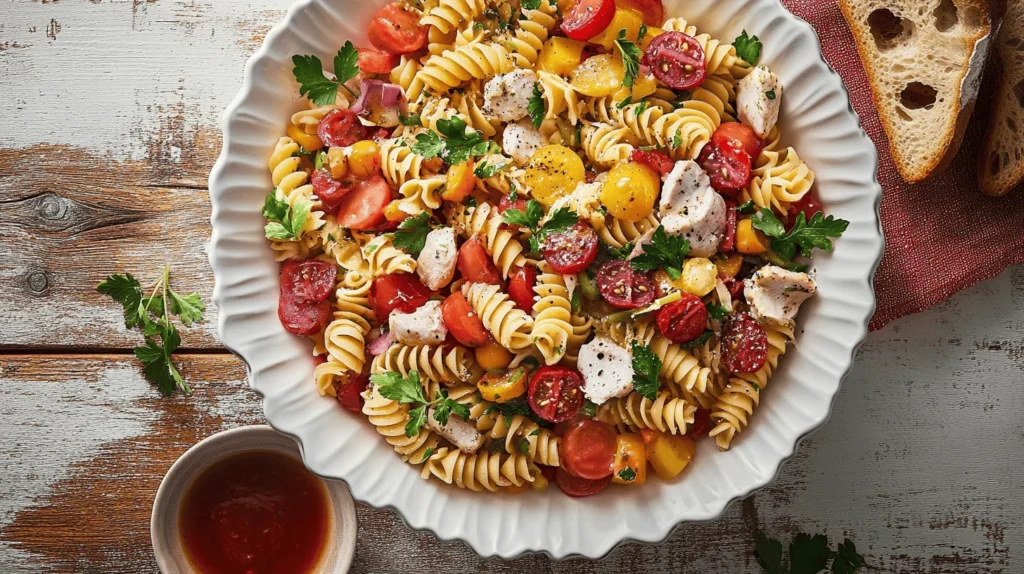
Storing and Reheating Tips:
Storage Strategies for Optimal Preservation
Italian Pasta Salad benefits from thoughtful storage methodology that maintains textural integrity and flavor vibrancy throughout its consumption window:
Primary Refrigeration Protocol:
- Store in airtight containers, ideally glass or BPA-free plastic with secure sealing capability. Glass provides superior aroma isolation, preventing the salad from absorbing or releasing odors in the refrigerator environment.
- Maintain consistent refrigeration between 34-38°F (1-3°C). Positioning away from the refrigerator door minimizes temperature fluctuations during normal kitchen activity.
- Optimal consumption window extends up to 4 days post-preparation, with peak quality occurring between 4-24 hours after assembly when flavors have melded but ingredients maintain structural integrity.
- If preparing multiple portions for individual consumption (such as meal prep scenarios), consider portioning into separate containers rather than repeatedly opening and closing a larger vessel, which introduces bacterial exposure and temperature variation.
Texture Preservation Techniques:
- For storage exceeding 24 hours, implement protective layering by placing more delicate ingredients (mozzarella, tomatoes) on top of the pasta rather than fully incorporated, adding them to the mixture only upon consumption.
- Reserve approximately 2-3 tablespoons of dressing in a separate container for refreshing the salad before serving, as the pasta will continue to absorb moisture during storage.
- If preparing significantly in advance (3+ days), consider more stable ingredient substitutions: cherry tomatoes rather than grape tomatoes for extended structural integrity; firmer cheeses like provolone instead of fresh mozzarella; and oil-packed rather than water-packed artichokes to prevent excessive moisture release.
Extended Preservation Considerations:
- While freezing is not recommended for assembled pasta salad due to textural degradation upon thawing, individual components can be prepared and frozen separately for future assembly. Cooked and properly cooled pasta can be frozen with a small amount of olive oil for up to 1 month, while dressing components can be measured and combined in freezer-safe containers for quick defrosting.
- For environmental sustainability considerations, reusable silicone storage bags provide an excellent alternative to single-use plastic, maintaining similar airtight capabilities while reducing waste.
Italian Pasta Salad: 7 Secrets to Perfection
Course: LunchCuisine: Italian-AmericanDifficulty: Easy6
servings15
minutes10
minutes460
kcalIngredients
- For the Dressing:
1/2 cup red wine vinegar
1/4 cup olive oil
2 Tbsp. Dijon mustard
1 tsp. sugar
- For the Salad:
1/4 red onion, thinly sliced
1/4 red onion, thinly slice
1 lb. rotini pasta
1 orange bell pepper, sliced
1 pt. grape tomatoes, halved
3/4 cup chopped marinated artichokes
1/3 cup pitted kalamata olives, chopped
4 oz. cured salami, such as Soppressata, chopped
2 Tbsp. chopped fresh flat-leaf parsley, plus more for serving
1 Tbsp. chopped fresh oregano
2 Tbsp. chopped capers
14 oz. fresh mozzarella, torn
Step-by-Step Instructions:
- Prepare the Pasta Foundation
Begin by bringing a large pot of water to a rolling boil. The water should taste notably saltysimilar to sea water as this is your primary opportunity to season the pasta from within. Add the rotini and cook precisely according to package directions for al dente texture, typically 8-10 minutes. The pasta should retain a slight firmness at its core, as it will continue to absorb moisture from the dressing. Proper pasta cooking technique creates the structural foundation upon which the entire dish depends. - Create the Flavor-Infused Base
While the pasta cooks, whisk together the red wine vinegar, olive oil, Dijon mustard, and sugar in a bowl until fully emulsified. The mustard serves as both flavoring agent and emulsifier, allowing the oil and vinegar to form a temporarily stable suspension. Transfer half of this dressing to a large bowl and immediately add the thinly sliced red onions. This critical step begins the transformation of raw onions, tempering their sharpness through acid exposure while simultaneously infusing the dressing with allium complexity. Allow this mixture to marinate while the pasta continues cooking. - Implement the Hot Pasta Technique
When the pasta reaches al dente perfection, drain it thoroughly but do not rinse. Immediate transfer the hot pasta directly to the bowl containing the onion-dressing mixture. Toss vigorously until all liquid is absorbed into the pasta. This technique represents the secret to exceptional pasta salad: the warm pasta, with starch molecules in their most receptive state, absorbs the flavored dressing deeply rather than merely being coated on the surface. Allow this mixture to cool to room temperature, approximately 15-20 minutes, during which time flavor infusion continues at the molecular level. - Incorporate Supporting Ingredients
Once the pasta has cooled to room temperature, it’s time to introduce the remaining components. Add the sliced orange bell pepper, halved grape tomatoes, chopped marinated artichokes, kalamata olives, chopped salami, fresh parsley, oregano, capers, and the remaining dressing. Gently fold these ingredients into the pasta mixture until evenly distributed. This careful integration ensures that each serving will contain a balanced representation of all components while preserving the structural integrity of more delicate ingredients like tomatoes and artichokes. - Add the Final Fresh Elements
As the culminating step, gently fold in the torn fresh mozzarella. This late addition prevents the cheese from absorbing too much dressing or breaking down from excessive manipulation. Finish with a generous sprinkling of additional fresh parsley, which provides both visual appeal and a final layer of herbal brightness. While the salad can be served immediately, allowing it to refrigerate for at least one hour (and ideally 2-4 hours) permits optimal flavor development as the ingredients continue to meld and marry in their chilled environment.
Nutrition Facts
- Calories: 460 kcal | Total Fat: 22 g | Saturated Fat: 7 g | Trans Fat: 0 g | Cholesterol: 40 mg | Sodium: 890 mg | Total Carbohydrates: 48 g | Dietary Fiber: 4 g | Sugars: 5 g | Protein: 18 g | Vitamin D: 0.2 mcg | Calcium: 210 mg | Iron: 2.5 mg | Potassium: 380 mg
Serving From Refrigeration
Italian Pasta Salad requires specific attention when transitioning from storage to service for optimal gustatory experience:
Temperature Adjustment Protocol:
- Remove from refrigeration approximately 20-30 minutes before intended consumption. This slight temperature moderation significantly enhances flavor perception, as cold temperatures suppress taste bud sensitivity to nuanced flavors.
- During this tempering period, keep covered to prevent moisture loss and potential bacterial introduction.
- If food safety concerns require immediate consumption from refrigeration, implement compensatory flavor enhancement through additional fresh herbs, a light drizzle of high-quality olive oil, or a small squeeze of lemon juice to counteract the perception-dulling effects of cold temperature.
Texture Rejuvenation Methodology:
- Just before serving, gently toss the salad to redistribute dressing that may have settled during storage.
- If the salad appears dry after refrigeration (a common occurrence as pasta continues to absorb moisture), implement one of these rejuvenation techniques:
- Add reserved dressing (ideal scenario if prepared in advance)
- Create quick emergency dressing with 1 tablespoon olive oil, 1 teaspoon red wine vinegar, and a small pinch of salt
- Add 1-2 tablespoons of the reserved pasta cooking water if stored separately
- For maximum texture contrast revival, add fresh elements just before serving: additional torn herbs, a sprinkle of toasted pine nuts, or fresh microgreens create textural interest that counterbalances any softening that occurred during storage.
Flavor Recalibration Considerations:
- Taste after refrigeration and consider subtle adjustments, as perception of seasoning particularly salt and acid changes during cold storage. Often, a light sprinkle of flaky sea salt or a few drops of vinegar immediately before serving restores optimal flavor balance.
- If serving to guests, consider accompanying plated portions with small dishes of potential flavor enhancers: lemon wedges, chili flakes, freshly cracked black pepper, and additional herbs allow personalized adjustment without altering the core preparation.
Through these methodical approaches to storage and serving, Italian Pasta Salad maintains its exceptional quality throughout its consumption window, providing both convenience and culinary satisfaction across multiple meals.
FAQ: Italian Pasta Salad
Q: Can I make this pasta salad ahead of time for a party? A: Absolutely! Italian Pasta Salad actually improves when made 4-24 hours in advance, as the flavors have time to meld. For optimal results, reserve a small portion of the dressing and a sprinkle of fresh herbs to add just before serving, which refreshes both the visual appeal and flavor brightness.
Q: How can I make this recipe vegetarian? A: Simply omit the salami and consider one of these flavorful substitutions: 1 cup marinated chickpeas, 3/4 cup oil-packed sun-dried tomatoes, or 1 cup grilled zucchini cubes. The cheese, vegetables, and tangy dressing provide ample flavor even without the cured meat component.
Q: My pasta salad seems dry after refrigeration. How can I fix this? A: This occurs naturally as the pasta continues to absorb dressing during storage. The professional solution is to reserve about 3 tablespoons of dressing when initially preparing the salad, then add it just before serving. If you didn’t reserve dressing, quickly whisk together 1 tablespoon olive oil with 1 teaspoon red wine vinegar and a pinch of salt, then toss with the salad to refresh it.
Q: Can I use a different shape of pasta? A: While rotini is ideal due to its spiral shape that captures dressing in its crevices, other medium-sized pasta shapes with texture or ridges work well too. Good alternatives include farfalle (bow tie), fusilli, penne rigate (ridged tubes), or orecchiette. Avoid long strands like spaghetti or very small shapes like orzo, which create textural imbalance with the chunky vegetables and cheese.
Q: What’s the best way to transport this to a potluck? A: Transport in a sealed container with a tight-fitting lid. If possible, bring the torn mozzarella separately in a small container and add it upon arrival, as this prevents the cheese from absorbing too much dressing during transport. Pack a small container of extra fresh herbs for garnishing just before serving for maximum visual impact.
Q: How long will this pasta salad keep in the refrigerator? A: When stored in an airtight container, Italian Pasta Salad maintains good quality for up to 4 days. The flavor profile actually improves over the first 24 hours, reaches peak quality between hours 4-24, then gradually begins to decline as fresh elements like herbs and tomatoes soften. For best results beyond day 2, consider refreshing with additional herbs and a light drizzle of olive oil before serving.
Q: Can I use bottled Italian dressing instead of making it from scratch? A: While technically possible, the homemade dressing requires just four ingredients and significantly improves the final result. Commercial dressings often contain stabilizers and preservatives that can create an artificial taste. If you must use bottled dressing, select a high-quality option labeled “premium” or “restaurant style” and consider enhancing it with a tablespoon of fresh lemon juice and additional fresh herbs.
Q: Is there a gluten-free version of this recipe? A: Yes! Simply substitute gluten-free rotini pasta, which is widely available in most supermarkets. When cooking gluten-free pasta, be especially attentive to the cooking time as it can quickly move from al dente to mushy. Some gluten-free pastas benefit from a quick rinse after cooking, contrary to the standard advice for wheat pasta.
Q: My family doesn’t like olives (or another specific ingredient). What can I substitute? A: This recipe is highly adaptable. For olives, consider substituting capers, pickled pepperoncini, or quick-pickled red onions to maintain the briny element. For bell peppers, try roasted red peppers or diced cucumber. If artichokes are the issue, consider hearts of palm or additional tomatoes. The key is maintaining balance between fresh, briny, savory, and herbal elements.
Q: Can I freeze leftover pasta salad? A: Freezing is not recommended for assembled pasta salad, as the texture of the vegetables and cheese significantly deteriorates upon thawing, and the dressing may separate. However, you can freeze cooked plain pasta (tossed with a bit of olive oil) for up to one month, then thaw and assemble with fresh ingredients for a quicker preparation in the future.

